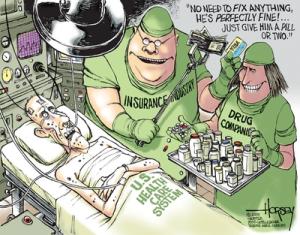- MENU
- HOME
- SEARCH
- WORLD
- MAIN
- AFRICA
- ASIA
- BALKANS
- EUROPE
- LATIN AMERICA
- MIDDLE EAST
- United Kingdom
- United States
- Argentina
- Australia
- Austria
- Benelux
- Brazil
- Canada
- China
- France
- Germany
- Greece
- Hungary
- India
- Indonesia
- Ireland
- Israel
- Italy
- Japan
- Korea
- Mexico
- New Zealand
- Pakistan
- Philippines
- Poland
- Russia
- South Africa
- Spain
- Taiwan
- Turkey
- USA
- BUSINESS
- WEALTH
- STOCKS
- TECH
- HEALTH
- LIFESTYLE
- ENTERTAINMENT
- SPORTS
- RSS
- iHaveNet.com
by Martha Lynn Carver

Look for employers to cut more deeply than ever into health care coverage for their workers in 2010.
Companies are getting walloped by higher than expected costs just when they can least afford it. Employers had figured on a 6 percent hike in health care this year, but it now looks as if the increase will be closer to 7.5 percent.
The spike is due to employees making more trips to the doctor and dentist and undergoing more exams, tests and treatment, a common occurrence in a recession.
It's driven by stress-related illnesses and by workers worried that they'd better race to use their benefits while they still have them.
Employers say that as a result of economic conditions, they will make more cost saving changes than usual to their health plans.
In a recent survey by Mercer, firms said they are planning on making changes to slow the increase in health costs to an average of 5.2 percent in 2010.
A popular method for cutting costs will be to embrace consumer-directed health plans.
When CDHPs were introduced in 2002, employers were cautious about adopting the plans, which combine high deductible insurance with tax advantaged savings accounts, either a health reimbursement account (HRA) or a health savings account (HSA).
"But employers are getting more comfortable with these plans, and our survey indicates they are planning the biggest increase we've seen to date in their adoption," says Beth Umland of Mercer.
About 14 percent of small employers and 25 percent of large (500-plus workers) ones now offer CDHPs. Mercer found that the percentage of employers offering CDHPs could double in 2010. About 60 percent of employers with CDHPs make a contribution to their workers' accounts. The average employer contribution is $640, while the average deductible is about $2,100.
CDHPs are significantly cheaper than PPOs (preferred provider plans). The average cost per worker of a CDHP is about $6,000 vs. $7,800 for a PPO.
"These cost savings are pushing some employers to adopt CDHPs faster than they would otherwise," says Umland.
Small employers are most likely to adopt CDHPs as a total replacement for PPOs, while larger employers usually offer them as one of several options. "But the direction, even among large firms, is toward total replacement," Umland says.
Large employers are luring workers into choosing the CDHP option with premiums that are much lower than those of their other plans. In 2007, 7 percent of large firms offered only CDHPs, and in 2008, the percentage had reached 12 percent.
WORLD | AFRICA | ASIA | EUROPE | LATIN AMERICA | MIDDLE EAST | UNITED STATES | ECONOMICS | EDUCATION | ENVIRONMENT | FOREIGN POLICY | POLITICS
Employers to Make Deeper Cuts in 2010 Health Coverage | Martha Lynn Carver - iHaveNet.com